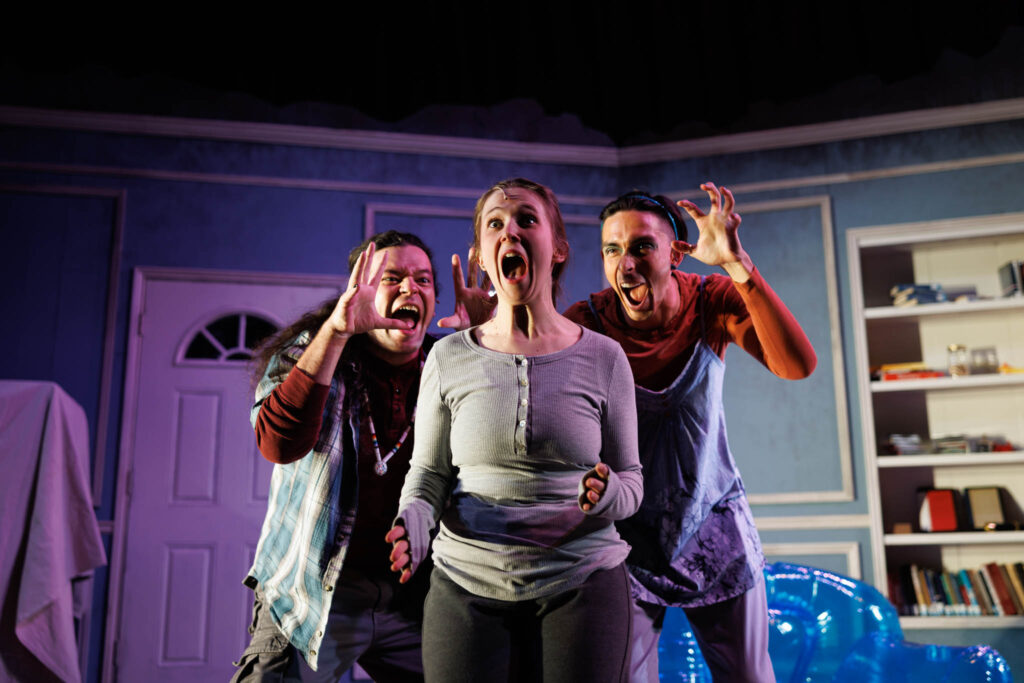Presented by Company One Theatre produced in partnership with the Boston Public Library with support from the National New Play Network and the Rolling World Premiere Program
Written, directed and choreographed by Tara Moses
Dramaturgy by Quita Sullivan
Fight choreography by Marisa Diamond
Community Advisor: Maria Hendricks
Jan. 24 – Feb. 15, 2025
Rabb Hall at the Boston Public Library, Central Branch
700 Boylston Street
Boston, MA 02116
Critique by Noelani Kamelamela
BOSTON — Comparisons between Tara Moses’ “Haunted”, Antoinette Nwandu’s “Pass Over” and Samuel Beckett’s “Waiting for Godot” are inevitable. So, yes, there are two main characters waiting for something in this play and amusing each other while they pass the time. I admit it. Fine. That’s it, that’s all I’m saying about those connections.
Below the surface, “Haunted” brings to life two young indigenous ghosts, Ash (Bradley Lewis) and Aaron (Chingwe Padraig Sullivan), who are rooted in one place while it changes around them. They constantly opine and long for freedom. One of their comforts and constants, the well-known hits of the early 2000s, provides emotional escape, but also constant reminders of how stuck and bored they have become.
I found “Haunted” refreshing on the world premiere weekend of all weeks which felt like a full month of crazytown-entitled white foolishness. The audience was clearly excited by the work even if it didn’t always unanimously agree with the action on stage. The first half was imaginative and expressive; Moses’ choreography used the entire space onstage at a fast pace from the moment the curtain came up to intermission. The limitations of Rabb Hall itself as a venue were used to great effect, especially since the smaller size meant that the music reached everyone in the audience with no echoes, and it was easy for most audience members to perceive both the supernatural and natural coexisting in our modern world.
Pre-intermission the pacing and stage pictures were refreshing and innovative. Our ghosts are not hollowed out zombies and the audience, though knowing they are ghosts, is introduced to them as if they are still alive. In fact, they seem very possessed and obsessed with the after-lives they are living. The audience became accustomed to that flow so, post-intermission, the once unexpected beats became familiar. Plot-wise, our heroic ghostly siblings learn about the Land Back Movement which is tied to whether or not they can ever leave the house they have been entombed in for 20 years. This act of the play is not a full explainer of the active political movement which, I do not believe, was Tara Moses’ goal. However, the show at this point fully leans into providing keywords and insisting that Land Back is a way for Ash and Aaron to go where they ascend to the Creator in the afterlife. This is not edutainment. This is presented as fact: supernatural fact in a play, but still.

Chingwe Padraig Sullivan, Katherine Callaway, Bradley Lewis (Photo by Ken Yotsukura Photography)
Okay, I lied. Nwandu and Beckett’s respective plays also include politics. The plays, without the context of the zeitgeist in which they arose and similar in their circularity, are unmistakably charged with the potential to be misunderstood. Moses, a citizen of the Seminole nation, Mvskoke, cannot be misunderstood here in the second act. The Land Back Movement is one option for non-Native folks to come into a right relationship with Native peoples, of which there are many options. The particulars of this process of making things right are not the concern of this play. Rather, we are called in to imagine a specific staged future we care about while feeling the effects of the more recent past.
My favorite theatrical elements brought forward and used regularly in the play were time expansion and time contraction. Lighting changes, music and staging styles such as mime and dance created a fluid sense of shared time. They presented jarring nonlinear experiences that viewers can decode through dialogue, costume, accent and set changes. These scenes are quite memorable and enjoyable. They were not always comic scenes, but they were always interesting.
I enjoyed this Pay-What-You-Want experience in one of my personal favorite library spaces in the world. Of course, I will mention, that while there is circularity in dialogue, the work passes at a 2-hour length. And, in terms of its two contemporaries that have been mentioned, nothing occurs onstage more horrifying than harsh language, racist verbal violence, and the idea that there are fates worse than death. I would caution those who may want to bring very young children given the length, but young adults and teenagers may find this an interesting way to pass the time.
“Haunted” passes on next to Native Voices at the Autry in Los Angeles, California and Cleveland Public Theatre in Cleveland, Ohio for both companies’ respective 2025-2026 theatre seasons.

Leave a Reply
You must be logged in to post a comment.